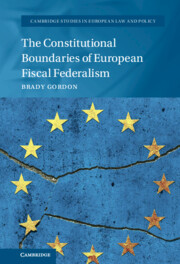Book contents
- The Constitutional Boundaries of European Fiscal Federalism
- Cambridge Studies in European Law and Policy
- The Constitutional Boundaries of European Fiscal Federalism
- Copyright page
- Basic Table of Contents
- Detailed Table of Contents
- Figures
- Acknowledgements
- Table of Cases
- Table of Legislation, Treaties and Conventions
- Abbreviations
- Part I
- Methods and Introduction
- 1 The Constitutional Boundaries of European Fiscal Federalism
- 2 The Maastricht Architecture of European Fiscal Federalism
- 3 The Failure and Abrogation of the Maastricht Model
- 4 Constitutional Criteria for EU Fiscal Federalism
- Part II
- Proposed Directions for Future Research and Reform
- Bibliography
- Index
Methods and Introduction
from Part I
Published online by Cambridge University Press: 07 April 2022
- The Constitutional Boundaries of European Fiscal Federalism
- Cambridge Studies in European Law and Policy
- The Constitutional Boundaries of European Fiscal Federalism
- Copyright page
- Basic Table of Contents
- Detailed Table of Contents
- Figures
- Acknowledgements
- Table of Cases
- Table of Legislation, Treaties and Conventions
- Abbreviations
- Part I
- Methods and Introduction
- 1 The Constitutional Boundaries of European Fiscal Federalism
- 2 The Maastricht Architecture of European Fiscal Federalism
- 3 The Failure and Abrogation of the Maastricht Model
- 4 Constitutional Criteria for EU Fiscal Federalism
- Part II
- Proposed Directions for Future Research and Reform
- Bibliography
- Index
Summary
The European Union (EU) has struggled with the meaning of fiscal federalism in Europe since the Treaty on European Union and the creation of the Economic and Monetary Union (EMU). The model of fiscal federalism inscribed in the Treaty at Maastricht conceived of national governments as distinct, miniature sovereign borrowers which retained the necessary fiscal competencies to manage sovereign economies. Central to the Maastricht model is a prohibition on financial assistance (Article 125 TFEU, ex Article 103 TEC) that enshrines a constitutional consensus on fiscal sovereignty and exposes Member States to market discipline and hard budget constraints.1 This follows a formula for federal equilibrium that is well established in theory and well evidenced in history, visible in the autonomous credit ratings of Swiss cantons, Canadian provinces and American states.2
- Type
- Chapter
- Information
- Publisher: Cambridge University PressPrint publication year: 2022

